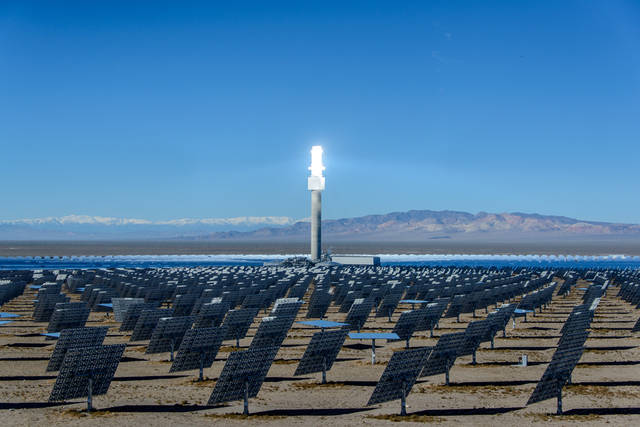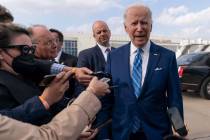RICHARD A. EPSTEIN: Forced migration to wind and solar could hamper Nevada economy
Last year, Nevada voters, by a 59 percent majority, endorsed Question 6, the Renewable Energy Promotion Initiative. If adopted again in 2020, it would amend the state constitution to require that 50 percent of the state’s energy portfolio come from renewables —wind and solar — by 2030. The consequences of this could be tragic for Nevada.
The initiative represents a semi-hysterical response to overblown claims of global warming caused by carbon dioxide. And to the extent carbon dioxide levels matter, Question 6 relies on ham-handed methods to deal with them.
Supporters of Question 6 presume that the world may well burn to a crisp if immediate and prompt steps are not taken to deal with rising carbon dioxide levels, rising temperatures and rising seas. But this causal chain is broken at every link.
Yes, carbon dioxide levels have climbed steadily over the past 100 years, from about 305 parts per million in 1920 to about 412 ppm today. But global temperatures have not moved in lockstep with those increases. Looking just at the past 40 years, global temperatures reached highs in 1998 and again in 2016, after which they plunged. Neither of these moves had anything to do with carbon dioxide levels. Both peaks were closely associated with the rise of La Nina (cooling water in the equatorial Pacific), and the decline of El Nino (warming waters). Indeed the 0.56 degree Centigrade (1 degree Fahrenheit) fall in temperatures between February 2016 and February 2018 marks the largest year-over-year decline in temperatures in the past 100 years, while carbon dioxide concentrations continued their slow rise.
Hurricanes and other extreme events, nationally and globally, exhibit a cyclical pattern that cannot be attributed to steadily rising carbon dioxide levels. Other factors matter, and recent studies in Finland, Japan and China all suggest that galactic cosmic effects could be the prime driver of temperature changes, relegating human-generated carbon dioxide to a bit player in a cosmic drama. Remember, too, that water vapor is also a greenhouse gas that is both more potent and more abundant. Claiming that carbon dioxide is “the” cause of global warming grievously oversimplifies the scientific record.
And that misattribution will have disastrous consequences if Question 6 receives an affirmative answer, for now the costly move to wind and solar will pour valuable resources down the drain for no good effect. Make no mistake about it, fossil fuels are vastly more efficient sources of energy. No matter what Nevada voters say, they will remain worldwide the central source of energy for decades to come. As Mark Mills of the Manhattan Institute has explained in his Report “The New Energy Economy: An Exercise in Magical Thinking,” a viable economy cannot rest on solar and wind energy. Both are intermittent and unreliable — and neither is pollution-free, after taking into account the huge energy costs needed to fabricate and dispose of windmills and solar panels, whose hum and reflected light respectively cause major environmental harm. Worse still, even with optimal technology, the physical limits on wind and solar energy sources mean that their efficiency can never exceed one-sixth of that of fossil fuels.
The good news here is that rapid advances in fracking and other techniques have driven down the total costs of producing fossil fuels through more efficient drilling and better disposal practices. And given that fossils count for more than 80 percent of world energy sources, these improvements generate huge social gains. In contrast, using massive subsidies to support solar and wind energy is always a mug’s game. Those subsidies have to come from somewhere, so that they either impose a senseless, targeted tax on fossil fuels, or a general tax that raises the cost for all goods and services. Nevadans will protest these higher costs by voting with their feet, relocating to nearby states — Arizona, and certainly not California — with more sensible energy policies.
Don’t fall, moreover, for the argument that Nevada should take the lead in combatting global warming from carbon dioxide. Any illusory reduction in carbon dioxide levels will produce at most a non-measurable reduction in global temperatures but huge dislocations from the mandated conversion to wind and solar energy. Higher prices for new vehicles, for example, will lead drivers to retain old clunkers that guzzle gas and emit fumes, which contain not only carbon dioxide, but really dangerous stuff such as nitrous oxide and sulfur dioxide. Yet Question 6 ignores the environmental damages caused by the delayed substitution of superior for inferior technologies because it rests on the naïve assumption that Nevadans are too preoccupied or dumb to respond to incentives.
The situation becomes only more glum when Question 6 is put into a global context. Over the past 30 years, U.S. carbon dioxide emissions have remained constant, notwithstanding that its population has increased from about 250 million to 330 million people. Gross domestic product has increased during that period from about $6 trillion to about $22 trillion. Clearly, the United States has made massive improvements by all these measures by the current mix of public and private initiatives. Over the same period, China and India have increased their emission levels by about 450 percent and 405 percent, respectively. If carbon dioxide matters, then all force and fury should be directed to having our Asian neighbors clean up their own act.
So what can Nevadans expect if they enact this foolish initiative? In the beginning, there will be some painful moves in the desired direction. But the climb gets steeper at each successive year. It is possible to increase the fraction of wind and solar in only two ways. First increase wind and solar and, second, reduce fossil fuels.
The supporters of Question 6 want you to think that the former will happen. But technology and economics won’t cooperate. So the latter will happen as the reduction in fossil fuels drives a potentially huge statewide economic decline.
Richard A. Epstein is a professor at the New York University School of Law, a senior fellow at the Hoover Institution and a distinguished service professor of law emeritus and senior lecturer at the University of Chicago. His Review-Journal column appears monthly.






















